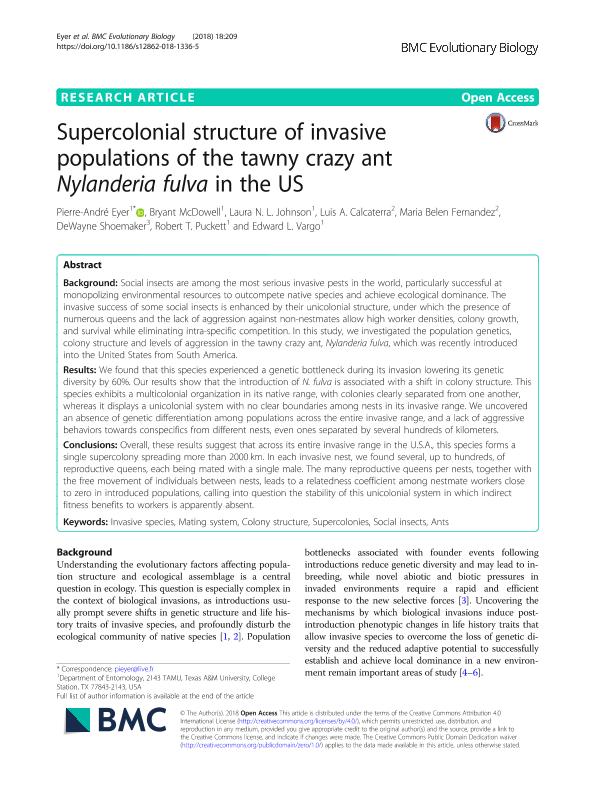Artículo
Supercolonial structure of invasive populations of the tawny crazy ant Nylanderia fulva in the US
Eyer, Pierre André; McDowell, Bryant; Johnson, Laura N. L.; Calcaterra, Luis Alberto ; Fernández, María Belén; Shoemaker, Dewayne; Puckett, Robert T.; Vargo, Edward L.
; Fernández, María Belén; Shoemaker, Dewayne; Puckett, Robert T.; Vargo, Edward L.
 ; Fernández, María Belén; Shoemaker, Dewayne; Puckett, Robert T.; Vargo, Edward L.
; Fernández, María Belén; Shoemaker, Dewayne; Puckett, Robert T.; Vargo, Edward L.
Fecha de publicación:
12/2018
Editorial:
BioMed Central
Revista:
BMC Evolutionary Biology
ISSN:
1471-2148
Idioma:
Inglés
Tipo de recurso:
Artículo publicado
Clasificación temática:
Resumen
Background: Social insects are among the most serious invasive pests in the world, particularly successful at monopolizing environmental resources to outcompete native species and achieve ecological dominance. The invasive success of some social insects is enhanced by their unicolonial structure, under which the presence of numerous queens and the lack of aggression against non-nestmates allow high worker densities, colony growth, and survival while eliminating intra-specific competition. In this study, we investigated the population genetics, colony structure and levels of aggression in the tawny crazy ant, Nylanderia fulva, which was recently introduced into the United States from South America. Results: We found that this species experienced a genetic bottleneck during its invasion lowering its genetic diversity by 60%. Our results show that the introduction of N. fulva is associated with a shift in colony structure. This species exhibits a multicolonial organization in its native range, with colonies clearly separated from one another, whereas it displays a unicolonial system with no clear boundaries among nests in its invasive range. We uncovered an absence of genetic differentiation among populations across the entire invasive range, and a lack of aggressive behaviors towards conspecifics from different nests, even ones separated by several hundreds of kilometers. Conclusions: Overall, these results suggest that across its entire invasive range in the U.S.A., this species forms a single supercolony spreading more than 2000 km. In each invasive nest, we found several, up to hundreds, of reproductive queens, each being mated with a single male. The many reproductive queens per nests, together with the free movement of individuals between nests, leads to a relatedness coefficient among nestmate workers close to zero in introduced populations, calling into question the stability of this unicolonial system in which indirect fitness benefits to workers is apparently absent.
Archivos asociados
Licencia
Identificadores
Colecciones
Articulos(SEDE CENTRAL)
Articulos de SEDE CENTRAL
Articulos de SEDE CENTRAL
Citación
Eyer, Pierre André; McDowell, Bryant; Johnson, Laura N. L.; Calcaterra, Luis Alberto; Fernández, María Belén; et al.; Supercolonial structure of invasive populations of the tawny crazy ant Nylanderia fulva in the US; BioMed Central; BMC Evolutionary Biology; 18; 1; 12-2018; 1-14
Compartir
Altmétricas



